Patrick DeCorla-Souza, Tolling and Pricing Program
Manager, FHWA
Lee Munnich, Humphrey Institute, University of Minnesota
Kenneth Buckeye, Minnesota Department of Transportation
John Doan, SRF Consulting
Center for Innovative Finance Support
Federal Highway Administration
Second Part of a Webinar Series on Overcoming the Challenges of Congestion
Pricing.
Session 2: Congestion Pricing Benefits, Challenges, and Opportunities
- Webinar
Audio:
- Via Computer - No action needed
- Via Telephone - Mute computer speakers, call 1-866-863-9293
passcode 57921078
Presentations by:
Audience Q&A: addressed after each presentation,
please type your questions into the chat area on the right side of the
screen
Closed captioning was available at: http://www.fedrcc.us//Enter.aspx?EventID=1742558&CustomerID=321
Upcoming Webinars:
You will be notified of the availability of the recording and PowerPoint
presentation from this webinar.
An Introduction to FHWA's Congestion Pricing Webinar Series - April
14, 2011
Federal Highway Administration
Office of Operations & Center for Innovative Finance Support
Presentation Outline
- Part 1: Rationale for and benefits of congestion pricing
- Part 2: Types of congestion pricing
- Part 3: Issues and challenges
More detail is provided in Congestion Pricing - A Primer: Overview
available at:
https://ops.fhwa.dot.gov/publications/fhwahop08039/cp_prim1_00.htm
Part 1: Rationale for and Benefits of Congestion Pricing
Tolling vs. Congestion Pricing
- "Tolling"
- Purpose to generate revenue
- "Flat" tolls
- "Congestion pricing"
- Purpose to manage demand to reduce congestion
- Tolls vary
- Results in a range of benefits
Strategies to Reduce Congestion
- Increase capacity:
- Physical capacity
- Management and operations
- Reduce demand
- Provide attractive "substitutes" for driving during
rush hours
- Congestion pricing
Economic Rationale
- Social costs of highway use:
- Internal - vehicle operation costs
- External
- Congestion: $78 Billion nationally (Texas Transportation
Institute)
- Carbon emissions: $20 Billion nationally (Steven Levitt,
University of Chicago)
- Costs not paid by user lead to overuse
August 25 Webinar - Economics of Congestion Pricing and Impacts
on Business
How Congestion Pricing Works
- Variable toll makes the cost borne by user
reflect the actual social cost of driving
- Willingness to pay - people will choose to
drive as long as the benefit they get is equal to the cost they
face
- Others will shift to using substitutes
Alternatives to Rush Hour Driving
- Alternative modes with traveler information
- Alternative destinations
- Alternative times
- Flextime, staggered work hours
Primary Benefits of Pricing
- Manages demand: Balances demand with supply
- Generates revenue for transportation investment
- Signals where additional capacity will maximize
benefits to travelers
- Contributes to USDOT strategic goals
1. Reduces Demand: Small Traffic Reduction Leads to Large Delay
Reduction
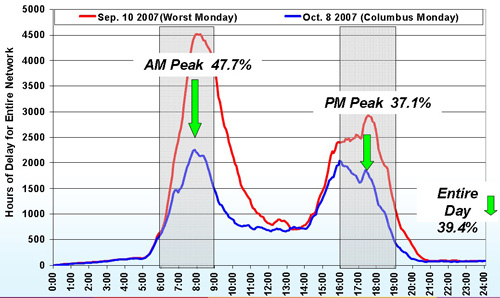
Impact on Congestion
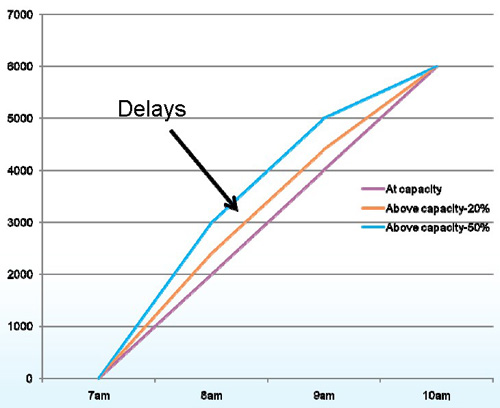
As the number of cars attempting to use the highway increases above
capacity 7am - 8am, each extra car causes about 2 hours of delay
to other vehicles.
Moving one driver to other modes will save 2 hours, or about
$20 in congestion costs
2. Generates Revenue to Pay Highway Costs
| Major Urbanized Areas |
Normal Cost |
High Cost |
| Construction cost/ lane mile* |
$13.4 M. |
$55.9 M. |
| Daily traffic volume in peak periods (5-6 hours/day) |
10,000 vehicles |
10,000 vehicles |
| Const. cost per vehicle per mile |
$1,340 |
$5,590 |
| Const. cost for 20-mile round trip |
$26,800 |
$111,800 |
| Annualized const. cost for 20-mile trip** |
$1,742 |
$7,267 |
| Cost for 20-mile trip per working day |
$7.00 |
$29.00 |
| Gas tax paid for 20-mile trip (2 cents/mile) |
$0.40 |
$0.40 |
*Source: FHWA, in 2006 dollars
**Annualization factor 0.065 assuming a 5.25% discount rate and 30-years
3. Provides Market Signals for Investment
- Congestion-based toll rates measure people's value
of the service
- Higher toll rates signal the need for investment in additional
capacity (highway or transit)
- Investments made at these locations will maximize social benefits
4. Supports Strategic Goals
USDOT's Strategic Goals:
- State of Good Repair
- Economic competitiveness
- Livable communities
- Environmental sustainability
- Safety
Summary of Benefits
- Large reduction in congestion delay
- New revenue for transportation
- Market signals for investment
- Supports USDOT strategic goals:
- State of Good Repair
- Economic competitiveness
- Livable communities
- Environmental sustainability
- Safety
Questions and Answers on Part 1
Part 2: Types of Congestion Pricing
Types of Congestion Pricing
- Priced lanes: HOT or Express Toll
lanes
- Priced highways
- Priced zones: Area or cordon
- Fully priced road networks: Commercial vehicles
or all vehicles
- Pricing not involving tolls: Parking and insurance
1. Priced Lanes
SR 91, Orange County, CA
- Four new lanes in median, 10 miles
- Tolls are $1.20 to $10.00
Variable Toll Rates
Maximum Toll Schedule for I-15 HOT Lanes, San Diego, California
- Evening Period Northbound
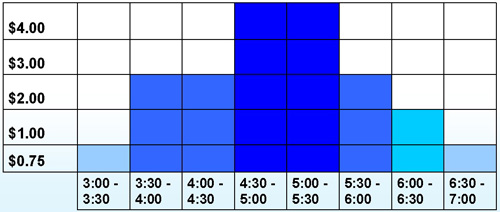
2. Priced Highways
- Proposed variable tolls on the State Route 520 floating bridge,
Seattle
- Tolls on the existing toll-free bridge
- Will help pay for the new expanded bridge.
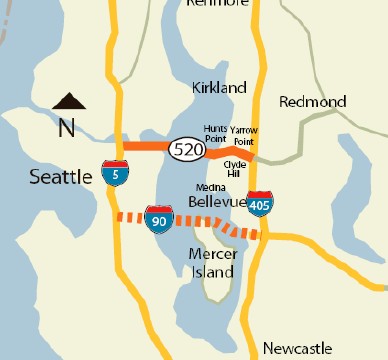
Toll rates on Singapore's Expressways

Charges vary from 50 cents to $2.50
3. Priced Zones
Stockholm Cordon Pricing:
- Cordon around center city
- Charges to enter and to leave central Stockholm
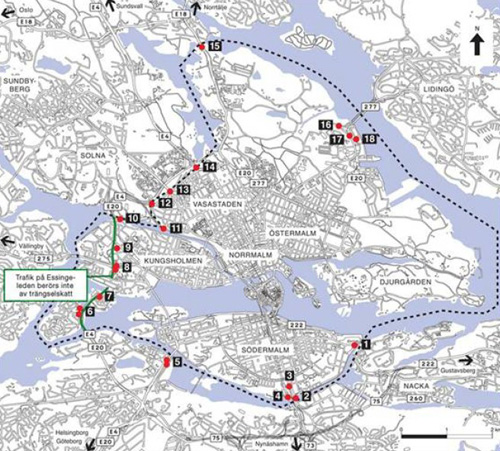
Stockholm's Cordon Toll Rates
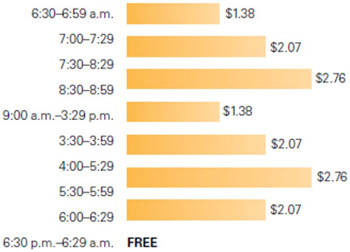
New York City Mayor's Proposal
- Cordon around Midtown and downtown Manhattan.
- Annual net revenue:
- $500 million
- Dedicated to transit
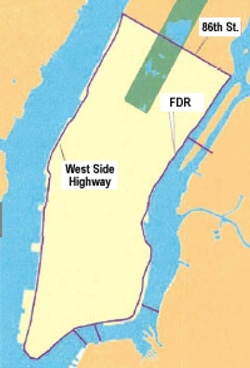
4. Fully Priced Road Networks
| Trucks only |
All vehicles |
- Germany
- Switzerland
- Austria
- Hungary
- Czech Republic
|
- Singapore (expressway system)
- US. metropolitan areas (planned)
- Seattle (Full facilities)
- San Francisco and Atlanta (Lanes only)
|
Long Range Plan: Seattle, WA
- Entire freeway system (all lanes) will be tolled
- Variable tolls will be used to manage demand
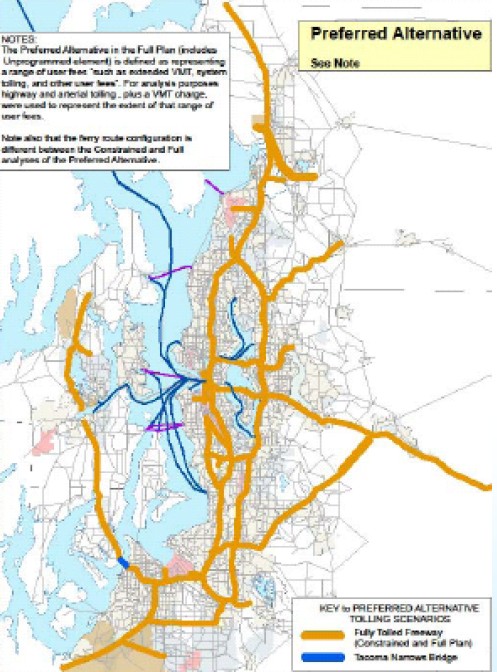
5. Pricing Not Involving Tolls
Parking Pricing
- San Francisco - Curbside and Off-street
Mileage-based car insurance
Employer-based parking cash-out
- Several California examples
Upcoming webinars:
- September 22 - Best Practices in Parking Pricing
- October 27 - Dynamic Ridesharing and Congestion Pricing
- November 17 - Pay-as-You-Drive Insurance
Key U.S. Congestion Pricing Projects
December 15 webinar - Results of the Urban Partnership and Congestion
Reduction Demonstration Programs
Key U.S. Projects
- Urban Partnership Agreements (UPA)
- Miami - I-95 Express Lanes
- Minneapolis - I-35W HOT Lanes
- San Francisco - Parking Pricing
- Seattle - SR 520 Bridge tolls
- Congestion Reduction Demonstration (CRD)
- Atlanta - I-85 HOT Lanes
- Los Angeles - I-110 and I-10 HOT Lanes
Congestion Reduction Strategies of the Sites
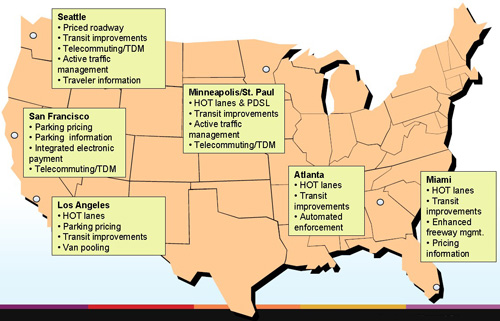
Miami
- HOT lanes on I-95 from Fort Lauderdale to downtown Miami
- Increased the occupancy from HOV-2+ to HOV-3+, requiring registration
- Expanded the 10-lane highway to 12 lanes
- Added 500 extra parking spaces at the Golden Glades Interchange
- Three new transit routes were introduced
- Twenty-three new articulated (58 seat) buses
- Added Ramp signaling and Transit Signal Priority
Minneapolis
- I-35W HOV to HOT Lanes, New HOT Lanes, and Priced Dynamic Shoulder
Lane (PDSL)
- 6 New or Expanded Park-and-Ride Lots
- 27 New Buses
- Transit Advantage Bypass
- Marquette and Second (MARQ2) Dual Bus Lanes in Downtown Minneapolis
- Real-Time Transit and Traffic Signs
- Driver Assistance for Shoulder-Running Buses
- Telecommuting/ROWE
San Francisco
- Parking Pricing - large-scale downtown parking pricing project
which will use intelligent parking management technology and techniques
- Real-time Information - Will inform customers about where parking
is available, to manage demand for a portion of the on-street and
off-street parking supply
- Parking Information will be provided via 511 Phone and Web
- 6,000 metered on-street parking spaces, 12,250 parking spaces
in 14 city-operated garages and one lot
Seattle
- Manage throughput and travel reliability with congestion
pricing and, partially fund the replacement of the SR-520
Lake Washington floating bridge
- Adding new transit service (including ferries)
and operational improvements
- Deploying active traffic management and other
technology applications to improve overall system efficiency
- Meld tolled and non-tolled system segments
for quicker and more reliable travel times throughout the region
- Work with major employers in the Lake Washington corridor to
enhance telework and travel demand reduction programs
Atlanta
- HOT Lane network on a 20 mile segment of I-85
- HOV vehicle occupancy designation was increased from HOV-2 to
HOT-3
- Two new park and ride lots
- Six new commuter coaches
Los Angeles
- HOT lanes - Convert the HOV facilities to HOT
for I-10 from I-605 to Union St. and I-110 from Artesia Transit
Center to Adams Blvd.
- Enhanced Silver Line BRT and New Feeder Services
- 41 new CNG buses for service on I-10 and I-110 plus 17 additional
buses deployed by local transit agencies for commuter service.
- Vanpools - Activities to support the formation
of 100 new vanpools.
- Transit Signal Priority - LADOT will install
bus signal priority technology at 19 signals in downtown LA.
- Park and ride improvements - Enhanced signage,
lighting, security, sound attenuation, and bus stop relocation at
8 Park and Ride lots along the Harbor Transitway
Questions and Answers on Part 2
Part 3: Congestion Pricing Issues and Challenges
Key Issues
- Institutional
- Equity
- Technology and Operations
- Relative effectiveness - benefits, revenue, environmental impacts
- Public acceptance
1. Institutional Issues
- Legislation: Federal and state
- Planning and project development
- Inter-agency collaboration
- Public involvement and outreach
Webinar on 4/19/11 - Institutional Issues in Congestion Pricing
2. Equity Issues
| Income-based equity |
Affordability of new charges |
| Modal Equity |
- Increasing the attractiveness of driving alone vs. taking
transit or carpooling
|
| Geographic equity |
- Ad-hoc tolling of some facilities in a region to make
up funding gaps
|
| Benefit-based equity (fairness) |
- Charges disproportional to benefits received May 26
Webinar - Congestion Pricing Equity Impacts
|
May 26 Webinar - Congestion Pricing Equity Impacts
3. Technology Issues
- Costs for implementation:
- Compared with minimal cost for fuel tax collection
- Operations:
- Open road tolling/all-electronic payment
- Interoperability - seamless travel
- Active traffic management
- Traveler information
June 23 - Technology to Enable and Complement Congestion
Pricing
4. Effectiveness Issues
| User benefits |
- Congestion reduction, etc.
|
| Environmental impacts |
|
| Revenue |
|
Seattle Study: Revenue vs. Cost
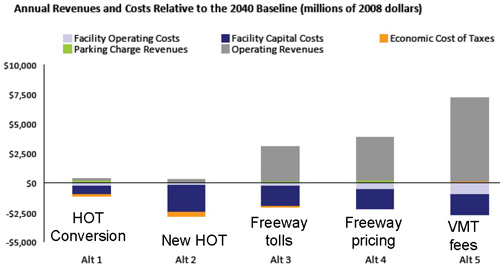
Seattle Study: Benefits vs. Costs
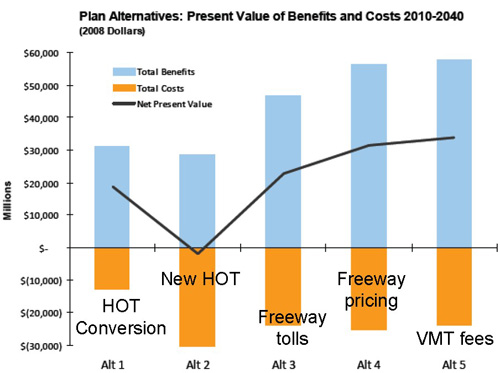
Seattle Study: Emission Reductions
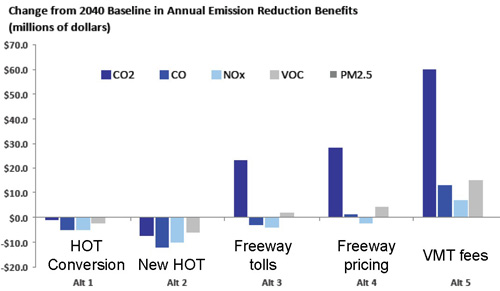
Effectiveness vs. Public Acceptance
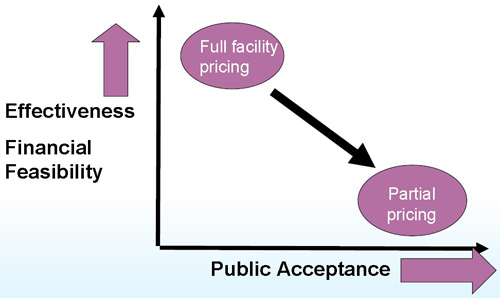
5. Public Acceptance Issues
- Paying twice
- Privacy
- Availability of travel alternatives
- Credibility and trust of government agency
- Traffic diversion
- Complexity
July 28 Webinar - Integrating Transit with Congestion Pricing
and Increasing Congestion Pricing Acceptance
Summary
- Congestion pricing has many benefits
- Operates successfully worldwide
- Innovative projects are being implemented or planned in several
U.S. cities
- Equity and public acceptance issues need to be addressed
Questions and Answers on Part 3
Upcoming Webinar - April 19, 2011
Institutional Issues in Congestion Pricing
To register, go to:
https://ops.fhwa.dot.gov/congestionpricing/
Upcoming Webinars - May through December 2011
- May 26 - Congestion Pricing Equity Impacts
- June 23 - Technology to Enable and Complement Congestion Pricing
- July 28 - Integrating Transit with Congestion Pricing and Increasing
Congestion Pricing Acceptance
- August 25 - Economics of Congestion Pricing and Impacts on Business
- September 22 - Best Practices in Parking Pricing
- October 27 - Dynamic Ridesharing and Congestion Pricing
- November 17 - Pay-as-You-Drive Insurance
- December 15 - Results of the Urban Partnership and Congestion
Reduction Demonstration Programs.
Registration will open at one month prior to each webinar.
Additional FHWA Products
- Primers, brochures, fact sheets, and other materials to inform
about various congestion pricing related topics.
- FHWA Tolling and Pricing web sites:













